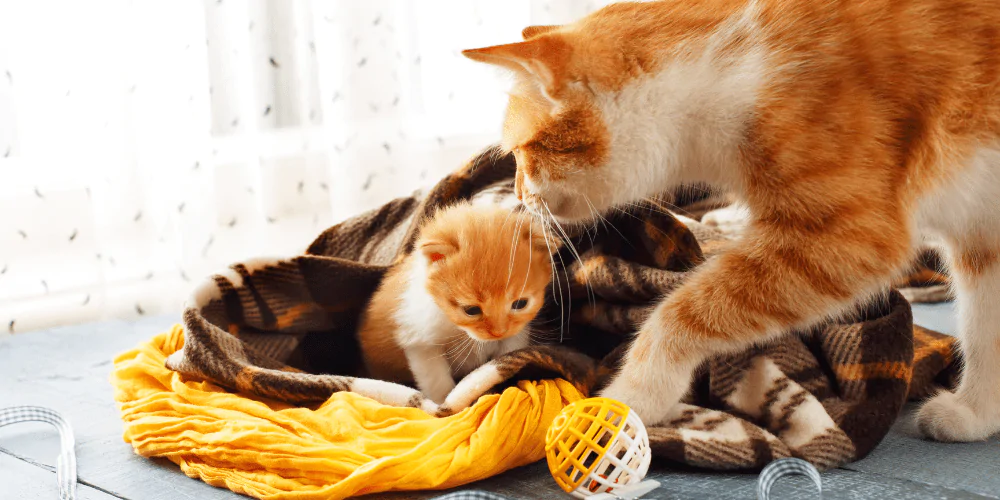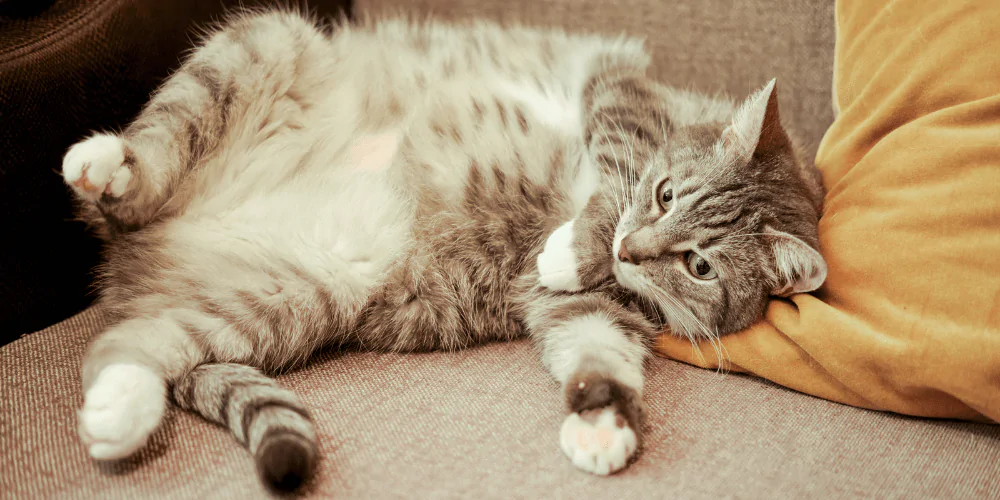
A behaviourist’s guide to cat pregnancy

Lucy Hoile
12 March 2024
Becoming pregnant is a big adventure for many cats, especially if they’re first-time mums.
Discover what behavioural changes to expect and learn how to look after your feline during pregnancy with advice from expert behaviourist Lucy Hoile.
- How do cats mate?
- What to expect in the stages of cat pregnancy
> First 20 days of cat pregnancy
> After the first 20 days of pregnancy
> Last two weeks of cat pregnancy - How to care for your cat during pregnancy
> Dos of cat pregnancy care
> Don’ts of cat pregnancy care
> How to create nesting spots for your cat - Other things to know about cat pregnancy
> Prenatal stress in cats
> Cat phantom pregnancy

How do cats mate?
First, let’s talk logistics – how does a cat get pregnant?
A female cat:
- Has a distressing experience when mating due to the barbs on the male cat’s penis – it’s these barbs that stimulate her egg release to get pregnant
- Usually mates with several males within a short space of time, so her litter can have multiple fathers
- Will mate with any male cat, including family members – there’s a good chance that two five-month-old, unneutered kitten siblings will mate with each other
Cats can mate from four months of age, so be careful about letting your unneutered feline outside until she’s at least a year old. Getting pregnant before this age means she won’t be mature enough to properly care for her kittens.
Remember to get your cat neutered as soon as she’s sexually mature if you want to avoid the risk of pregnancy. And keep in mind that cats can become pregnant again just six weeks after giving birth.

What to expect in the stages of cat pregnancy
> First 20 days of cat pregnancy
Cat pregnancy usually lasts around nine to 10 weeks. You probably won’t notice your feline is pregnant during the first few weeks after mating as nothing changes physically or behaviourally.
Some of the first signs include:
- Your cat is no longer going into heat (which normally happens every few weeks)
- A swollen abdomen
- Pink and protruding nipples
Your vet will be able to carefully feel the kittens around 20 days after mating.
> After the first 20 days of pregnancy
You’ll see a shift in your cat’s behaviour after those initial 20 days of pregnancy. Now she’s:
- Less active and resting/sleeping more
- Hungrier and eating more
- More affectionate to people she trusts with lots of purring, roly polys, and leg rubs
- Possibly more aggressive towards people she doesn’t know or is nervous around
- Potentially less tolerant towards other animals, wanting more space and not sharing things like beds
> Last two weeks of cat pregnancy
As your cat gets closer to her due date, you’ll notice:
- She has a much larger abdomen
- The kittens are moving around when she’s lying down (depending on how many she’s having)
- Her mammaries have become enlarged, ready for feeding
- Nesting behaviour as she looks for somewhere safe and suitable to have the kittens
- Increased restlessness and pacing
- Reduced appetite – she’ll stop eating when she’s going into labour

How to care for your cat during pregnancy
Your queen needs extra special care and attention while she’s growing her babies. So here are a few dos and don’ts during your cat’s pregnancy.
> Dos of cat pregnancy care
- Keep your cat healthy and be careful of parasite control – your vet can suggest pregnancy-safe flea and worming options
- Speak to your vet about feeding her a high-energy kitten food or one labelled for mum and babies
- Throw your cat’s previous feeding routine out of the window – let her eat what she wants and increase the number of meals if needed
- Make sure there’s plenty of fresh water everywhere that she has easy access to at all times
- Keep her inside during the last two weeks of pregnancy so she doesn’t have the kittens outside
- Give her the fuss she wants when she asks for it
> Don’ts of cat pregnancy care
- Try and feel the kittens in her stomach as even a prod could do damage
- Handle mum unnecessarily as this could also harm the kittens
- Worry about overfeeding her as she’ll regulate herself
- Over-fuss her and bother her when she’s sleeping or just not in the mood
- Interfere with the birth as she can handle this herself – just watch from afar and call your vet if you’re worried
> How to create nesting spots for your cat
You’ll want to give your cat plenty of nesting options at least two weeks before she’s due. Remember that she will choose the spot herself – drawers and cardboard boxes work well. Make sure the nesting areas are:
- In quiet places where she won’t be disturbed
- Somewhere warm and away from drafty windows and doors
- Lined with something like a blanket that you can swap out once she’s had the kittens
- Within close access to a high place that your cat can use to get some time away from the kittens
- Close to a food and water bowl
- Close to a litter tray that’s positioned away from the food and water bowls

Other things to know about cat pregnancy
> Prenatal stress in cats
It’s important to make sure your feline isn’t stressed during her pregnancy as this passes on to her kittens.
They’ll find it hard to develop in a safe environment if they were born to a mum who has been in ‘survival mode’. This mentality is common for strays and feral cats who’ve struggled to find food and safe resting areas.
Kittens born with this ‘survival mode’ will be:
- More reactive and sensitive
- Less able to tolerate stress
- Showing hypervigilant behaviour
- More likely to fight with other cats
Kittens born to a feral/stray or a stressed parent will be behaviourally different to a mum born and raised in a relaxed, safe home.
> Cat phantom pregnancy
Phantom pregnancy is a phenomenon where a female cat experiences the symptoms of pregnancy without actually being pregnant. These symptoms can range from:
- Mothering behaviour
- Milk production
- Vomiting
- Abdominal contractions
- Increased appetite and weight gain
Phantom pregnancy isn’t very common in cats. Most cases are mild and resolve themselves within a few weeks without any need for treatment.
Vets might prescribe hormone supplements or a hysterectomy if your feline is having frequent phantom pregnancies. The condition can be completely avoided if you neuter your female.


